Deep penetration primer (impregnation)
Surface priming is one of the stages in the finishing work chain. It is needed often, but not always. First, you need to know what composition is needed - when you need a deep penetration primer, and when a filling, adhesive. This is important as improper use can cause problems: loose plaster, swollen tiles, etc.
The content of the article
Types of primers and their purpose
In the description of many types of work it is written: a base primer is required. For this stage, special formulations are used, which are called a primer or primer.
What is a primer (primer) or primer? It is a liquid mortar that prepares the surface for the next coat of finishing. Moreover, the "next" can be any, both intermediate and finishing. Take wall decoration, for example, from bare masonry to paint or wallpaper. First, the building material itself is primed. After the soil has dried, plaster is applied. When the plaster dries enough, apply a primer to it, then putty. The putty surface is also primed, and then, after the primer layer has dried, paint or paste wallpaper... This number of coats of primer is not necessary, but possible.
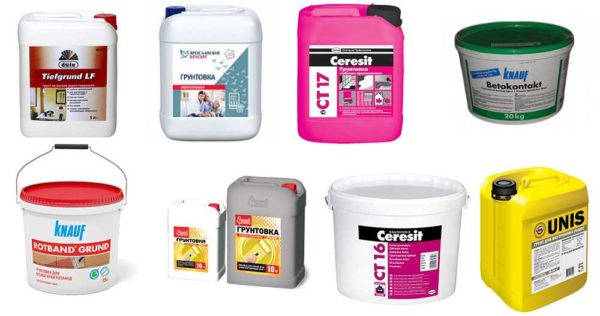
The primer is a liquid composition that provides good adhesion of the finishing layers to each other.
A primer is used for finishing walls, floors, ceilings, and facades. In general, everywhere. There are subspecies for external and internal work, which are used both there and there.
Types of primers
As you saw from the example, the base on which the primer is applied is different. For example, a concrete wall and a foam block, a concrete floor, a plasterboard ceiling or putty. They are completely different in characteristics. This means that different preparation is required, covering the problems of a specific material. There are primers for each task. In general, according to the results of the action, four groups are distinguished:
- Fillers. These are compounds that reduce the hygroscopicity of the base, its absorbency. Apply to highly absorbent surfaces. Designed for leveling small irregularities and filling joints in ceramic tiles, plank floors and parquet before filling. They are applied:
- under the paint to reduce its consumption and so that it lays down more evenly,
- under the plaster so that the wall does not draw moisture from the plaster compound and it has enough moisture to gain the required strength,
- on a plastered wall under tile glue to slightly extend the "lifespan" of the glue due to the fact that the liquid will be absorbed more slowly,
- on plaster or putty before wallpapering, so that the surface absorbs glue more slowly, etc.
- Film-forming or adhesive. These formulations are applied to low-absorbency substrates to improve adhesion. After drying, a sticky film remains on the surface, on which it is easier to apply, for example, plaster. As you can see, another problem is being solved. The film-forming primer increases the adhesion (materials "adhere" better).
- Deep penetration or penetrating. This type of primer is used for those substrates that cannot be dedusted.Gypsum plasters, chalk paints and other surfaces that leave a dusty mark on the hands. The task of this type of formulation is to bind dust particles and ensure normal adhesion to the next layer.
- Strengthening. This is a special type of primer that is used to bond loose substrates. This is a subspecies of deep penetration soils, but they contain more of an adhesive component, due to which they bind particles not only in a small surface layer, but also to a decent depth. They are usually used for renovations in old houses or for restoration / restoration of finishes.
There are also universal primers. They are the cheapest. The description usually contains a fairly solid list of properties. In fact, universal primers contain the least active ingredients. This is also a soil, but weaker. This type should only be used if a primer is not urgently needed. For example, under wallpaper or paint.
Tasks solved by primers
The primers must ensure good adhesion of the two layers. This is their main purpose. Most often this requires adjusting the absorbency of the substrate. The fact is that all finishing materials - plasters, putties, paints, glue - are developed for medium-absorbent substrates. And there are not so many of them. More often it is necessary to regulate the absorbency. Sometimes it is necessary to reduce the absorbency, sometimes to create a sticky film on a surface that is too smooth and / or poorly absorbent. Here are the primers and solve this problem.
And also formulations that reduce absorbency, simultaneously improve waterproofing and fight high humidity. So this is also their task. And for this they are also used.
Deep penetrating primers bind particles on the surface. The compositions penetrate deep into loose materials to a sufficient depth of 5-7 mm and bind the particles together. Often a "side" effect is a decrease in hygroscopicity and absorbency. Often - this does not mean always, so see the properties in the description of each composition.
Even on the surface after the primer has dried, an adhesive film may form, since the non-absorbed composition leaves a sticky mark after drying. This improves the conditions for applying the next material. That is, some types of primer increase surface strength and adhesion. Some other formulations have antibacterial properties, while others are simply injected with special anti-mold or antifungal additives.
Sometimes a primer is used to "make friends" materials based on cement and gypsum. Without this, there will be no normal adhesion. For example, when a concrete wall or a wall made of cement-based blocks is going to be covered with gypsum plaster, the classic and proven solution is Betonokontakt from Knauf. It can be applied to almost any mineral substrate under gypsum materials and provides a high-quality bond.
Types of bases for primer
So, we came to the conclusion that when choosing a primer it is necessary to focus on the properties of the base. According to their absorbency, they are divided into three groups:
- Low absorbency and non-absorbent. This group includes concrete surfaces, cement plasters, refractory bricks, sand concrete, expanded polystyrene, gypsum tongue-and-groove slabs.
- Medium absorbency. Ordinary brick. An ideal base that does not require priming. But only if the brick has not yet begun to crumble.
- Highly absorbent. Gas silicate, aerated concrete blocks and any aerated concrete, white silicate bricks, gypsum and lime, cement plasters and mixed plaster mixtures.
How to determine the absorbency of a surface? Apply water droplets to the surface and track the time it takes for them to be absorbed. If it took more than 20 minutes, the surface is non-absorbent, if it took less than 3 minutes, it is highly absorbent. Everything in between is medium absorbent. In this case, you are in luck and you can do without formulations that regulate water absorption.
Now it is clear how to select a primer. For surfaces with low absorbency, film-forming ones are suitable, and for those with high absorbency, deep penetration primers or fillers are suitable. Deep penetration is needed only if the surface is dusty, but not loose or crumbling.
What is a deep penetration primer for and how does it work
An indicator for the use of a deep penetration primer is a dusty surface. That is, the dust cannot be removed completely. How can I check this? A surface is considered "dusty" if a trace remains on the hand after touching, even after careful and (if possible) damp cleaning. Only in this case it makes sense to use this type of primer. In other cases, it will be cheaper to use film-forming or fillers.
So what kind of surfaces is deep penetration primer used for? For chalk surfaces, gypsum plaster before painting or wallpapering. Do I need to prime the gypsum under the gypsum plaster? No, they will be good friends anyway. It will also be necessary to process all sheet materials in which gypsum serves as a binder: gypsum plasterboard, gypsum plasterboard, tongue-and-groove plates.
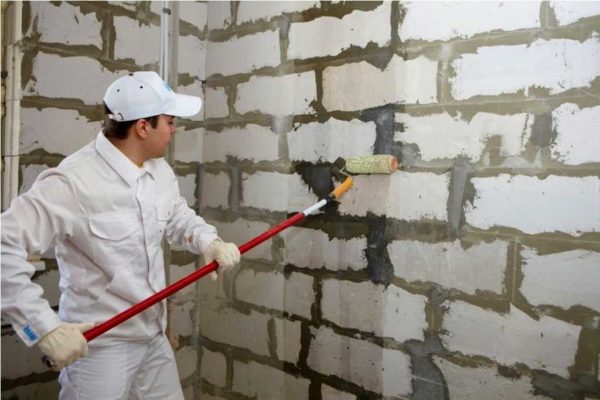
If the material is on a lime or gypsum binder, it is "dusty". To prevent this from happening, deep penetration primers are applied
Asbestos is also treated with a deep penetration primer, although it is not on gypsum, but it is dusty. And also silicate blocks before applying a layer of plaster. They also leave a layer on the hand. In general, it seems clear.
Note! The surface to be treated must not be loose. There is a special primer for this, which is called strengthening. It also refers to deep penetration soils, but contains a greater amount of adhesives (and is more expensive). If applied unnecessarily, the absorbency may be too low, leading to problems.
How deep penetrating soil works
How do deep penetration primers work? They are made on the basis of the same polymers, only modified in such a way that the particles are very small in size. The difference can be gauged by comparing a soccer ball and a tennis ball. The difference between particles in ordinary and penetrating soils is approximately the same. It is clear that smaller particles penetrate deeper.
Very fine polymer particles dissolve and penetrate with the liquid through capillaries deep into the primed surface. After drying, the polymer particles remain in the capillaries, creating an additional crystal lattice there and reducing the porosity of the material (and its absorbency at the same time), creating additional bonds between the particles of the material. As a result, after processing, the surface stops "dusting".
What happens when processing with a conventional soil composition? Moisture is absorbed into the surface, while larger polymer particles remain on the surface, only slightly penetrating inside. After drying, the polymer is concentrated in the upper small layer. This is sufficient for normal non-dusting substrates. Now, hopefully, the difference between a regular primer and a deep penetrating one is clear.
Deep penetration primer: which is better
As usual, there are many different brands on the market. There are Russian and imported ones. Of the imported ones, there are often German Knauf, Polish Ceresit. These are companies that have been on the market for many years. There are very few complaints about the quality of their products. Here are just a lot of fakes and you need to know well the distinctive features of authentic products.
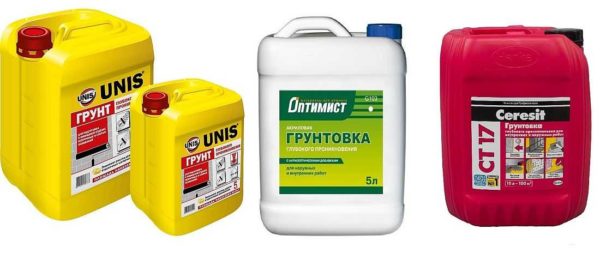
Deep penetration primer: what is needed for it seems to be clear, but you also need to choose a manufacturer
There are also Russian manufacturers who have also been on the market for a long time and who monitor quality - these are Yunis, Prospectors, Volma. Tellingly, the difference in price with the “Europeans” is quite small - no more than 10-15%. There are also cheaper brands, for which the difference is more significant - up to 30%, but the reputation is unstable. And if you look at the description, you can find the difference.
Deep penetration primers: characteristics, prices, consumption
| Name | Appointment | Binder type | For what reasons | Under what layers | Drying time | Consumption | Price | Notes |
|---|---|---|---|---|---|---|---|---|
| Ceresit CT 17 / st 17 (Ceresit CT 17) | For interior and exterior use | Acrylic copolymer aqueous dispersion | Concrete, cement-sand and lime plasters and putties, lightweight and cellular concrete, chipboard, fiberboard, gypsum plasterboard, gypsum plasterboard | screed, self-leveling floor, gypsum plaster, all types of putties, tiles, paint, wallpaper | 2 hours | 0.1-0.2 l / m2 | 10 $ for 10 l | Has a yellow color, it is problematic for painting or light wallpaper |
| CT 17 Concentrate | For interior and exterior use | The same, but a concentrate that is diluted with water | 0.1-0.2 l / m2 | |||||
| Deep Penetration Primer Prospectors | For interior and exterior use | Styrene-acrylic dispersion with antiseptic additives | Concrete and concrete screeds, bricks, plasters, putties, gypsum plasterboard, gypsum plasterboard, cement concrete | screed, self-leveling floor, gypsum plaster, all types of putties, tiles, paint, wallpaper | 1 hour | 0.1-0.2 l / m2 | Not suitable for lightly absorbent surfaces, oil paint and steel | |
| Strengthening primer Vetonit Vetonit.Prim Multi | For interior and exterior use | Acrylic dispersion | Concrete, plaster, brick, stone, drywall, aerated concrete, foam block, putty, cement surfaces, cement-bonded concrete, gypsum board, GLV | for painting, waterproofing, floor levelers, for acrylic, silicate, silicone paints | 1-2 hours | 0.05-0.075 l / m2 | $ 11.4 for 10 liters | On slightly absorbent substrates can be applied twice |
| Deep penetration soil before filling KSH (10) BIRSS | For interior and exterior use | Acrylate | Concrete walls and ceilings of normal and increased strength (weakly absorbent), gypsum board, gypsum plasterboard, plaster (except for polymer), | Before puttingty or water-based paints | 1 hour before tack | 0.2 - 0.25 kg / m2 | $ 9.5 for 10 liters | |
| Strengthening KNAUF-TIFENGRUND (Knauf tiefgrund) | For interior and exterior use | Polymers | Gypsum and cement plasters, gypsum plasterboards, gypsum plasterboards, gypsum tongue-and-groove plates, gypsum and cement screeds | Putty, paint, wallpaper, tiles | 3 hours | 0.1 kg / m2; | 12 $ for 10 l | |
| Leningrad NPP deep penetration primer | For outdoor work | Acrylic dispersion | Foam concrete, aerated concrete, old plaster, concrete and brick surfaces, gas silicate, slag concrete, plaster | For subsequent finishing layers | 4 hours | 0.16 kg / sq.m. | $ 2 for 1 liter | Do not use on poorly absorbent substrates, lime plaster and whitewash |
| Bolars | For interior work | Acrylic | All types of aerated concrete, cement-sand screeds, plasters (except for polymer), fiberboard, chipboard, brick | For mortars, paints, finishing materials | 1 hour before overcoating and 2 hours for other materials | 0.08 kg / m2 | 7 $ for 10 liters | Use gloves, glasses, respirators |
| VD AK 0301 | For indoor work, for outdoor work (different compositions) | Acrylic dispersion | On mineral surfaces | For painting, tiles, wallpaper, putty, for applying on a concrete floor | 24 hours | 0.08-0.1 kg / m2; | from $ 7.6 to $ 12.7 for 10 liters, depending on the type | There is an antiseptic and for old paint |
| Volma Wagon | For interior and exterior use | Styrene acrylate dispersion | Tongue slabs, gypsum board, gypsum plasterboard, cement screed, putties, brick | 2.5 hours | 0.1-0.15 kg / m2; | $ 9 for 10 liters | On highly absorbent aerated concrete bases. apply two layers of foam concrete | |
| Glims (Glims-Primer Prime) with antiseptic additives | For interior and exterior use | Brick, concrete, foam concrete, plaster, putty, drywall, asbestos cement | Plaster, putty, glue, paint | 30 minutes before the next coat | 0.08-0.2 kg / m2; | 10 $ for 10 liters | ||
| Birss soil M (hardening, stabilizing, frost-resistant) | For interior and exterior use | Acrylic copolymer | On plaster, putty, brickwork | 20 hours | 0.15-0.2 kg / m2; | 9 $ for 10 l | Not recommended for polymer plasters and putties | |
| Unis (Eunice) with antiseptic | For interior and exterior use | Polymer dispersion | Concrete, plaster, aerated concrete, gypsum plaster, brick. gas silicate, GVL, TsPS, tongue-and-groove plates, | For painting, plaster, wallpaper | 30-40 minutes before the next layer and several hours for subsequent work | 0.15 kg / m2; | 6 $ for 10 l | Works with wood, does not let efflorescence on brick |
| Deep Penetration Primer 2-in-1 TEKS Universal | For indoor and outdoor use, for walls, floors, facades | Polymer | Wood, concrete, plasterboard, putty | For painting, wallpaper | 30-40 minutes | 0.07-0.2 kg / m2; | ||
| Expert Perfekta | For interior and exterior use | Polymer | Concrete, brick, aerated concrete, cement and gypsum plasters and putties, gypsum plasterboard, gypsum plasterboard, cement-bonded concrete, paint, wood, tile | Plasters, putties, tile adhesives, water-based paints and varnishes, self-leveling floors. | 1 hour | 0.15 - 0.2 l / m2 | $ 7.3 for 10 liters | |
| Optimist (anti-bacterial) | For interior work | Acrylic latex | Concrete, gypsum plasterboard, gypsum, cement plaster, mineral and wood surfaces | Varnishes, paints, including water-based paints | 30 minutes before the next coat of primer and 2 hours completely dry | 0.1 - 0.25 l / m2 | $ 6.3 for a 10 L canister | |
| Optimum Leningrad paints | For interior use, for walls | Acrylic | Concrete, plaster, drywall, brick, wood | Water-based paints, tile adhesive, wallpaper | 0.07-0.2 kg / m2; | $ 4.3 for 5 liters |
As you can see from the table, it will not work to say that there is no difference between more expensive and cheaper brands. Even according to the description of the surfaces on which the composition is applied. There are significantly more surfaces for more expensive compounds. Well, you have to look at the quality. But usually, cheaper ones are taken for applying paint (if it is not expensive), for gluing wallpaper, etc. For more critical areas - such as plaster, putty, on complex bases - they prefer not to take risks and take the products of trusted firms. A perfectly justified approach.
Application rules
The rules for applying primers of any type are the same. The deep penetration primer is also applied to a dry, clean substrate. Dry is a residual moisture of about 3-5%. Clean - free of oil and dirt stains, loose materials. Here are just "dust-free" - this is not for this case. Although all dusty particles must be removed. If dusty work was carried out, we go through the walls with a brush, sweep the floor, wash it if necessary and wait for it to dry.
Further, the soils are applied to warm substrates. We look at the minimum allowable temperature in the description, but usually it is not lower than 10-15 ° C, but there are frost-resistant compounds. They can be applied to surfaces with a temperature of + 3 ° C. Note. This is the surface temperature.
Compositions can be applied with a brush, roller, spray gun, spray gun. Some of them contain a coloring pigment that allows you to control the application. But in some cases - under paint or light wallpaper - the presence of pigment can interfere, as it can distort colors. Therefore, we take a transparent or white primer for finishing light materials.

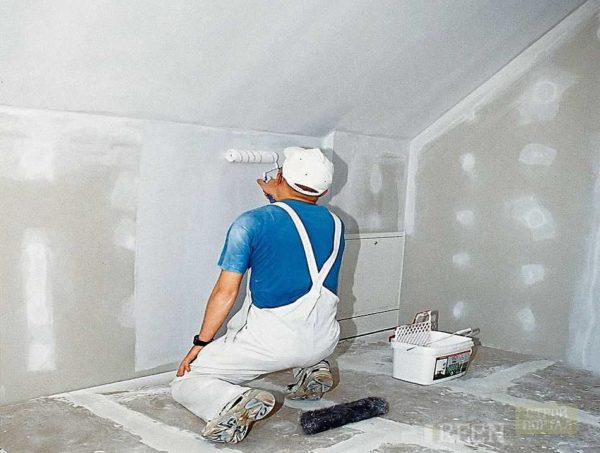
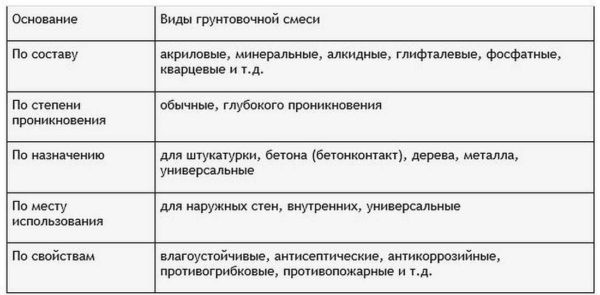
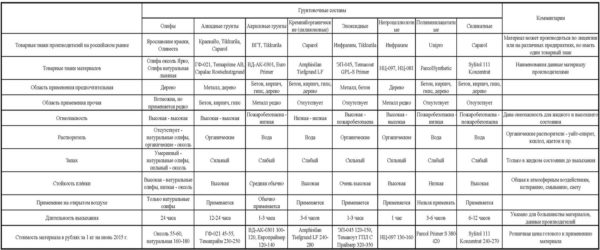
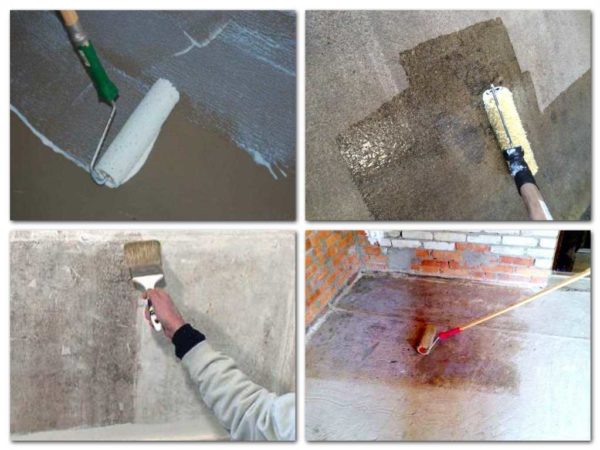
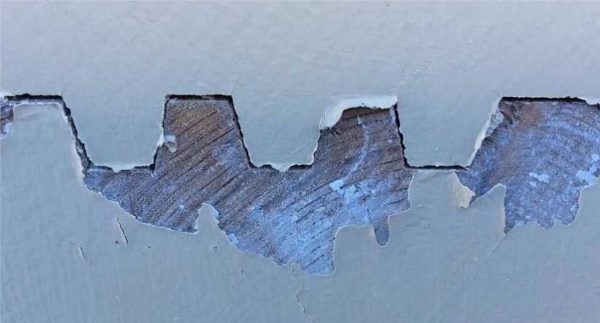
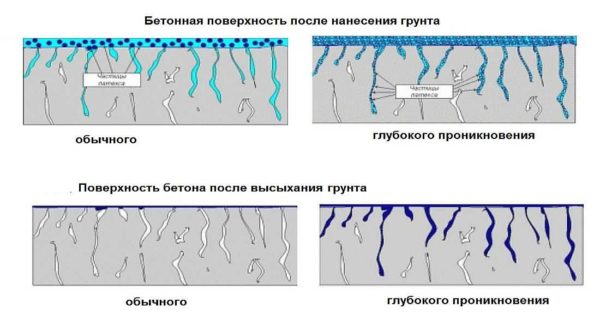
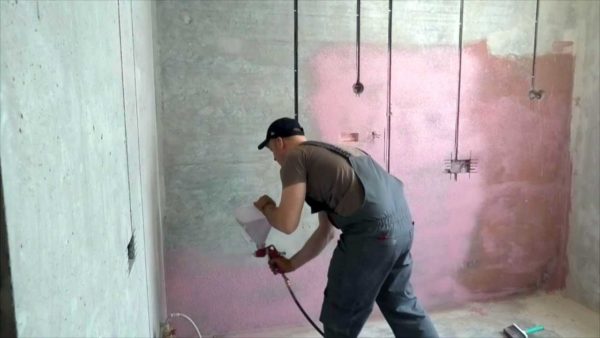










I went into the store and saw two versions of primers - one with a blue marker, the other without. The difference in the price of a 5 litas canister is 30 rubles. I decided to take it with a marker. Well, you can't see him on the cement floor. So in vain I overpaid 30 rubles 🙂
The marker is clearly visible on the wall prepared for wallpapering, i.e. when the wall is covered with white water.